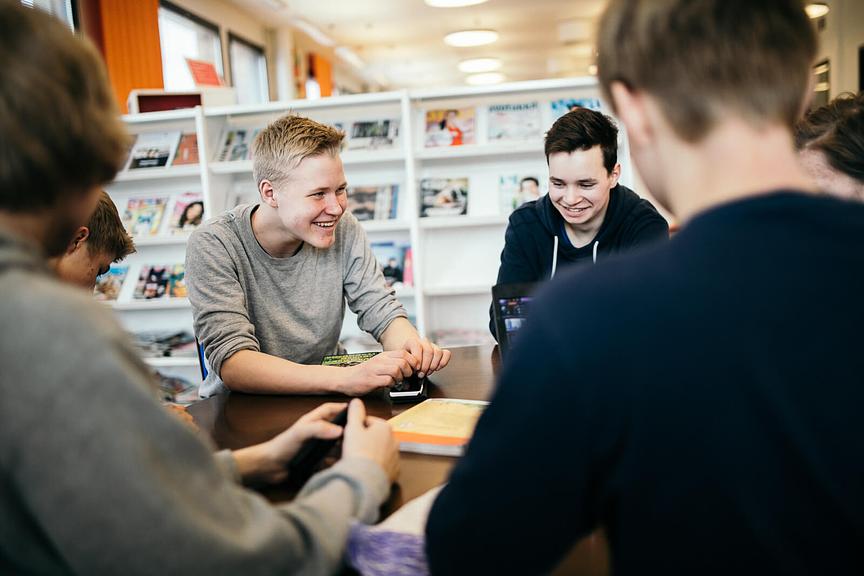The goal of the lesson: Learning about being present and relaxation.
The lesson in a nutshell
- Discussing the benefits of calming down and mindfulness. Talking about the benefits to student wellbeing that come from calming and quieting down.
- Icebreakers for discussing the benefits of being calm and present together. Mindfulness exercises linked to awareness and being present.
- Homework: Being aware of your breathing by counting to ten with your fingers.
More on the topic
NOTE! Teaching mindfulness to children requires a teacher who has experience with mindfulness. This innovation provides you with plenty of exercises to fit your teaching style. These exercises for being present can be instructed using the recording or video – whatever feels easiest and natural to you.More on mindfulness for children.
Videos for your teaching:
Mindfulness exercises for young children (6–10-year-olds):
- Mindfulness Meditation for Kids
- 😊 🌺 Breath Meditation for Kids 😊 ❤️ Mindfulness for Kids
- Peace Out Guided Relaxation for Kids | 1. Balloon
Mindfulness videos for older students (10–18-year-olds):
- The Scientific Power of Meditation
- How to Meditate
- Benefits Of Meditation - TOP 6 BENEFITS
1. Introduction – When we're present and relaxed, we feel good
Explain the benefits of being present. When we're consciously present and calm, we feel good. When we're present, we notice more around us and can feel more positive emotions.
When we're relaxed and present, we hear, learn and see better. We also find it easier to be kind to others when we're relaxed and calm. You can and should practice calm and conscious presence.
2. Icebreakers on being presentBodily sensations and feelings while relaxing
- Ask the students when they feel calm and relaxed? How do they feel in those moments? What kind of situations are they and where do they occur?
- Discuss the students' best methods to calm themselves and relax. Collect students' tips about the best methods to calm themselves on the blackboard. Discuss these experiences.
Exercises for being present with the studentsNOTE! Test the exercises yourself before you instruct one for the students.
Focusing on your breathing by counting
One of the easiest ways to practice conscious presence is to turn your attention to your body and breathing. One exercise is to consciously breathe and count the inhales and exhales by raising a finger after inhaling and exhaling until five or ten fingers are raised.
This exercise provides the students with a concrete method of calming themselves. Extending your exhale is especially effective for relaxation and calming down.
Focusing on your breathing with a video
Instructed breathing exercise
Sound – being present in the moment through hearing
You can practice being in the moment and consciously present with your senses by focusing on audio, for example. You can do this exercise with an instrument, such as a bell, triangle or guitar.
Play one or more chords and ask the students to listen as long as the sound is audible. When there is no more sound, they can raise their hand. You can do this short and easy exercise either with the students' eyes closed or open. You can use it to bring the students back to the calming present.
Chocolate – being present in the moment through all of your senses
Give the students chocolates (or raisins.) The goal is to eat them as slowly as possible using all of your senses and calming down in the process. First, they take the chocolate in their hand, look at it, feel it, smell it, touch it and listen to it before they put it in their mouth.
The students place the chocolate in their mouth slowly, let it melt, move, taste, etc. in their mouths. Slowly, they swallow the chocolate and taste the lingering aftertaste. At the end, you should discuss what you all felt and sensed, respecting everyone's experiences.
After the exercise
After you complete the exercise of your choice, ask the students how they felt during and after it. Gather everyone's experiences and discuss what students noticed during the exercise – was it easy or hard; what feeling did they have; what do their bodies feel like now?
3. Homework: Being aware of your breathing by counting to ten with your fingersHomework is to breathe in and out ten times counting it with your fingers. They should do this once a day and you should practice it together beforehand using the exercise provided above.
Ask the students to choose a time to complete the daily exercise. They should write in their notebooks the answer to the question: “How do I feel after the breathing exercise?”
After a week, discuss the students' experiences. If you want, you can do the exercise together at the school before or after a lesson.



